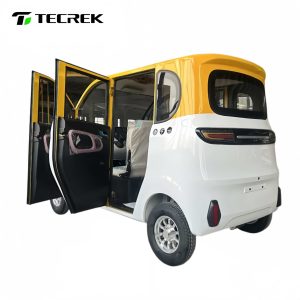Introduction
According to Fortune Business Insights, the global low-speed vehicle (LSV) market is projected to reach USD 17.8 billion by 2032, growing at a CAGR of 9%. As sustainability goals intensify and cities seek cleaner last-mile solutions, Electric Micro-Mobility Future Trends have become a central theme in modern transport innovation.
With its advanced electric vehicle technology and smart design, Tairui is spearheading the evolution of community mobility, campus fleets, and commercial micro-EV applications.

I. Market Overview: The Rise of Electric Micro-Mobility
1.1 Market Growth & Regional Insights
The Electric Micro-Mobility Future Trends movement is gaining traction in North America, Europe, and Asia.
According to MarketsandMarkets (2025), North America remains a dominant market for LSVs due to increasing demand for sustainable neighborhood vehicles and golf-cart conversions.
1.2 Urban Transformation & Last-Mile Demand
Urban congestion and the “last mile” gap have accelerated interest in micro electric vehicles and neighborhood EVs. Compact electric transport options reduce emissions, noise, and space usage — aligning perfectly with Electric Micro-Mobility Future Trends.
II. Key Technologies Driving Micro-Mobility
2.1 Modular Batteries & Lightweight Chassis
Tairui integrates modular lithium battery packs and aluminum-alloy chassis to balance performance, safety, and affordability. This structure enhances driving efficiency and extends lifespan — a hallmark of Electric Micro-Mobility Future Trends.
2.2 Connectivity, IoT & Data Analytics
Equipped with IoT systems, Tairui vehicles support remote diagnostics, fleet tracking, anti-theft alerts, and cloud-based updates. Such smart connectivity enables fleet operators to optimize utilization, reflecting the micro-mobility revolution globally.
2.3 Safety & Global Compliance
Tairui adheres to FMVSS 500 (U.S.) and EU L6e/L7e standards, ensuring vehicles meet safety benchmarks for braking, lighting, and crash protection — essential to consumer trust within Electric Micro-Mobility Future Trends.
III. Challenges & Opportunities
3.1 Infrastructure & Charging Gaps
While LSVs require smaller charging networks, urban deployment still faces infrastructure challenges.
Tairui partners with energy companies and local governments to build smart charging solutions for community-scale mobility.
3.2 Regulatory Variations
Diverse road regulations across states and countries limit LSV deployment. Gradual introduction through campuses, gated communities, and industrial zones offers a pragmatic path for Electric Micro-Mobility Future Trends expansion.
3.3 User Awareness & Market Adoption
Tairui engages in global exhibitions and strategic media outreach to build awareness and trust. Public education about micro-mobility’s benefits is key to widespread acceptance.
IV. Tairui’s Strategic Roadmap
4.1 Product Segmentation
Tairui’s LSV portfolio includes:
Urban micro EVs for daily commuting
Campus & tourism electric shuttles
Utility LSVs for logistics and maintenance
Each product embodies the Electric Micro-Mobility Future Trends philosophy — safe, smart, and sustainable.
4.2 International Expansion
Tairui has established dealer networks in Southeast Asia and Europe and is preparing for EU-standard compliant models in 2026. Its vision is to position itself among leading low-speed electric vehicle innovators worldwide.
4.3 Sustainability Commitment
From manufacturing to recycling, Tairui maintains a low-carbon lifecycle strategy, aligning with global ESG goals and reinforcing the Electric Micro-Mobility Future Trends ethos.
Conclusion
The Electric Micro-Mobility Future Trends era signifies a turning point in sustainable transportation. Through innovation, digitalization, and community-level deployment, low-speed electric vehicles are reshaping the future of urban movement.
With visionary engineering and eco-mobility philosophy, Tairui stands ready to redefine smart, efficient, and green short-distance travel for the coming decade.
